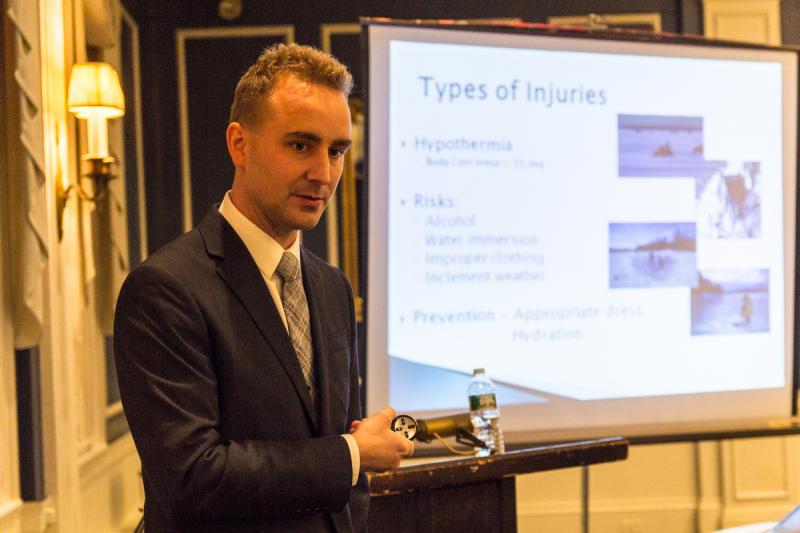Sports medicine specialist program on braving winter sports
Whether it's downhill skiing or shoveling snow in the driveway, there's a right and wrong way to do everything.
In preparation for the winter season, Dr. Chad Beattie held a seminar on winter sports injuries to inform people about concussions, the difference between warming up and stretching, and a vast array of other healthy tips.
In at the intimate “Winter Sports 101: Common Injuries and How to Prevent Them,” Beattie, the director of Hawthorn Medical Associates Comprehensive Concussion Clinic, dispelled myths surrounding health and wintertime exercise and shared his professional advice on how to keep themselves safe and healthy.
The program is part of the fall series sponsored by Saint Anne’s Hospital Center for Orthopedic Excellence.
"Winter sports are fun and safe,” Beattie assured. “We have some unique challenges where we live."
Beattie touched upon a wide variety of topics, though most of them were “common sense,” he said. During his tenure at Killington Mountain, Vermont as a sports injury fellow, the vast majority of injuries he tended to happened in skiers who ignored the rules, skied above their level, were dehydrated, out of shape or alone.
All winter activity from shoveling snow to hiking in the mountains starts with proper attire. Beattie advised locals to wear three layers: a base layer of skin-tight fabric to wick away moisture; a middle layer of fleece or down for warmth; and a breathable outer layer for protection from the elements.
As an avid hockey fan and skier himself, Beattie also discussed common injuries and concerns that come along with these and other winter activities.
Concussions were a major concern among the crowd. A concussion occurs when one takes a jarring blow to the head. According to Beattie, concussions are more traumatic in pediatric patients than adults because the brains of kids are still developing.
Various concussion tests are available. However, there is no treatment for concussions except to rest until the effects have abated.
Interestingly, though popular, extensive testing has shown that mouth guards, helmets and headgear are not only not effective in preventing concussions, they can increase the risk of getting concussions in the case of high contact sports like football and soccer. However, he strongly advises people to wear helmets for skiing, snowboarding, skating and other such activities.
“[Helmets] won’t stop a concussion. Prevents death, though,” Beattie remarked.
Another big source of injury is shoveling snow due to bad technique.
“I see more snow shoveling injuries than anything else from January to March,” Beattie said.
He advises people to use ergonomic shovels, to bend slightly at the hips and knees when shoveling, and to throw snow aside – not behind – to avoid rotator cuff injuries.
Many injuries can be avoided if people take the time to warm up before and cool down after physical activity. Warming up constitutes light aerobic exercise like jumping rope, jumping jacks or lightly jogging followed by squats, lunges, hip and arm rotating exercises, or using a foam roller to stretch.
The purpose of this activity is to warm the muscles, raise the heart rate, and increase blood flow and synovial fluid, which lubricates joints.
Traditional, static stretching where one sits in place can increase the risk of injury and can weaken muscles.
David and Linda Brooks were very pleased with the wide variety of topics that Beattie discussed.
“We’re big skiers, and we’re getting old and starting to feel aches and pains outside of skiing,” David said. “So it was nice to see some of the doctor’s ideas on what you should do before and after.”
David has been playing soccer – or football as he vocally preferred to call it – for as long as he’s been able to stand on his own two feet. He never bothered to stretch before playing so he’s suffered a number of hamstring and groin injuries from not warming up.
“[He’ll] carry on the way [he is],” Linda joked.
“I’ll [stretch] because she’ll nag me,” David quipped back.
















